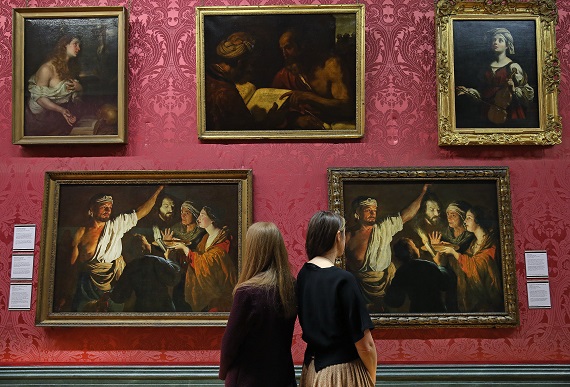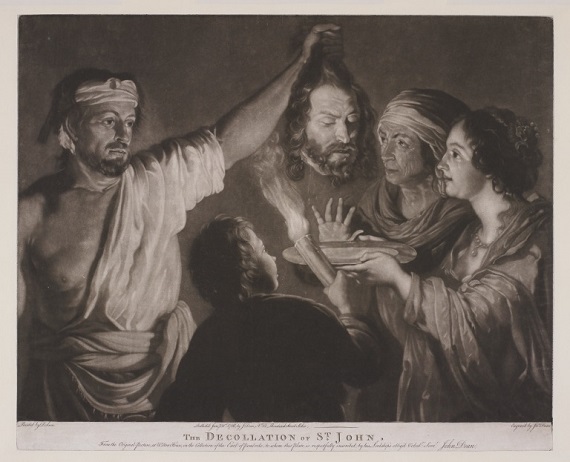Britain and the Baroque: The legacy of William Dobson
/Left: The Walker Art Gallery’s spring display Baroque Art from Rome to England (30 March – 16 June 2019), featuring Matthias Stom’s Salome receives the Head of John the Baptist, on loan from the National Gallery, alongside William Dobson’s copy © Gareth Jones / National Museums Liverpool
Right: Mezzotint print by John Dean after William Dobson, 1786 © National Museums Liverpool
Kate O’Donoghue, National Gallery Curatorial Trainee with Art Fund support and the assistance of the Vivmar Foundation, discusses William Dobson and the new spring display at the Walker Art Gallery:
From 30 March – 16 June 2019 at the Walker Art Gallery in Liverpool, two 17th-century paintings will be reunited for just the second time in almost 400 years: the National Gallery’s grim depiction of Salome receiving the head of John the Baptist by Matthias Stom, and William Dobson’s copy from the Walker’s collection.
Dobson – one of England’s greatest painters – lived and worked in extraordinary times. When Charles I’s chief painter Anthony van Dyck died at the end of 1641, with the country on the brink of civil war, Dobson stepped into the role. A short time later, in 1642, the young artist left the capital to join the king’s stronghold in Oxford. It is here, in the early years of the Civil War, that Dobson likely made his copy.
Dobson’s painting is considered the only 17th-century English picture to be painted in the style of Caravaggio. Due to the Catholic tastes which they expressed, Counter-Reformation Baroque paintings were controversial and rare in England. Despite this, an appreciation and taste for Caravaggist painting had grown in royalist circles, perhaps explaining how Stom’s picture found itself in Britain.
Dobson rented one of the most expensive rooms at the college of St John the Baptist at Oxford University, a space which he probably used as a painting studio. While we do not know for certain, it is here that Dobson may have painted his version of John the Baptist’s demise, possibly choosing the subject as a tribute to the college’s namesake.
17th-century biographer John Aubrey remarked that Dobson was accompanied at St John’s college by an assistant, ‘one Hesketh a Hedge-Priest’. Presumably, Hesketh was a fugitive priest who offered mass in secret for Catholics. Along with St John’s College’s rumoured Catholic affiliations, Hesketh’s acquaintance with Dobson is curious. Particularly considering Aubrey’s frank description of the man, it seems unlikely that Dobson could have been unaware of Hesketh’s activities.
In the midst of this, Dobson produces perhaps the most Catholic English picture of the 17th century. He kept the work in his possession until he died in 1646, when it passed to his wife, Judith. So controversial, even dangerous, was this painting that she kept it hidden from view. It spent some time in the possession of ‘an Oxford tavern keeper’ before it was sold to the Earl of Pembroke. It spent several generations with the Pembrokes at Wilton house before surfacing on the London art market in the early 1950s, finally purchased by the Walker in 1955.
Similarly, Stom’s picture appeared on the London art market in the 1950s after spending several generations with the Earls of Malmesbury. James Harris, father of the first Earl of Malmesbury, acquired the painting in 1779 and observed that there was a very similar picture at Wilton House, indicating his awareness of Dobson’s painting.
While Dobson’s picture is the only known English Caravaggist painting of the 17th century, it is perhaps not alone. Isaac Fuller (c.1606-1672) made his own – unfortunately now lost – copy of Dobson’s painting. Fuller was said to have modelled Salome on his mistress, and the older woman on her mother.
This raises an interesting question about Dobson’s work. There are numerous differences between Stom’s painting and Dobson’s copy, some more subtle than others. Perhaps the most striking is the variation in the figure of Salome. Stom’s Salome has been painted in a classical, almost sculptural style, her profile resembling one typical of a Roman coin. In contrast, Dobson’s Salome is far more naturalistic and, through her jewellery and hair, she is styled in an English manner.
Dobson, known mostly for his portraits and for documenting the faces of the English Civil War, is famous for his ‘warts and all’ approach to portraiture. Stom’s idealised Salome has no real place in a Dobson painting. Instead, is it possible that Dobson’s Salome is a portrait and, if so, of whom?
In the later part of the 18th century, while Dobson’s picture was in the Earl of Pembroke’s collection at Wilton House, John Dean produced a mezzotint copy of the painting. One print made in 1783 is in the Royal Academy’s collection, while a later version dated 1786 was acquired by the Walker along with the painting in 1955. The Walker print will be displayed alongside the Dobson and Stom paintings from 23 April – 16 June and further explores the legacy of Caravaggism in British art. Produced in London in the 1780s, Dean’s prints coincide with the career of Joseph Wright of Derby (1734-1797), whose style is also derived from elements of Caravaggio and his followers.
Viewing these works together explores the spread of taste and style in the 17th century and beyond, across Europe and within Britain itself. Particularly seeing these two paintings up close and side by side, we are encouraged to contemplate Britain’s relationship with Europe during one of the most turbulent periods in British history. These paintings provide a fascinating glimpse into it.
Baroque Art from Rome to England (30 March – 16 June 2019), Walker Art Gallery (Room 3), Liverpool. Free exhibition, no booking required.





